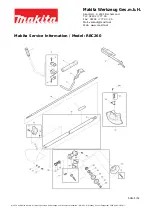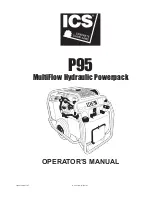
4
5
Causes and Operator Prevention of
KICKBACK:
KICKBACK is a sudden reaction to a
pinched, bound or misaligned saw blade,
causing an uncontrolled saw to lift up and out
of the workpiece toward the operator.
When the blade is pinched or bound tightly
by the kerf closing down, the blade stalls and
the motor reaction drives the unit rapidly back
toward the operator.
If the blade becomes twisted or misaligned
in the cut, the teeth at the back edge of the
blade can dig into the top surface of the wood
causing the blade to climb out of the kerf and
jump back toward operator.
KICKBACK is the result of saw misuse and/or
incorrect operating procedures or conditions
and can be avoided by taking proper precau-
tions as given below:
• Maintain a fi rm grip with both hands on
the saw and position your arms to resist
kickback forces. Position your body to
either side of the blade, but not in line
with the blade.
Kickback could cause
the saw to jumb backwards, but kickback
forces can be controlled by the operator,
if proper precautions are taken.
• When blade is binding, or when inter-
rupting a cut for any reason, release the
trigger and hold the saw motionless in
the material until the blade comes to
a complete stop. Never attempt to re-
move the saw from the work or pull the
saw backward while the blade is in mo-
tion or kickback may occur.
Investigate
and take corrective actions to eliminate the
cause of blade binding.
• When restarting a saw in the workpiece,
center the saw blade in the kerf and
check that saw teeth are not engaged
into the material.
If saw blade is binding,
it may walk up or kickback from the work-
piece as the saw is restarted.
• Support large panels to minimise the
risk of blade pinching and kickback.
Large panels tend to sag under their own
weight. Supports must be placed under
the panel on both sides, near the line of
cut and near the edge of the panel.
• Do not use dull or damaged blade.
Unsharpened or improperly set blades
produce narrow kerf causing excessive
friction, blade binding and kickback.
• Blade depth and bevel adjusting lock-
ing levers must be tight and secure
before making cut.
If blade adjustment
shifts while cutting, it may cause binding
and kickback.
• Use extra caution when making a
"plunge cut" (or pocket cut) into ex-
isting walls or other blind areas.
The
protruding blade may cut objects that can
cause kickback.
• Check lower guard for proper closing
before each use. Do not operate saw if
lower guard does not move freely and
close instantly. Never clamp or tie the
lower guard into the open position.
If
saw is accidentally dropped, lower guard
may be bent. Raise the lower guard with the
lower guard lever and make sure it moves
freely and does not touch the blade or any
other part, in all angles and depths of cut.
• Check the operation of the lower guard
spring. If the guard and the spring are
not operating properly, they must be
serviced before use.
Lower guard may
operate sluggishly due to damaged parts,
gummy deposits, or a buildup of debris.
• Lower guard should be retracted
manually only for special cuts such as
"plunge cuts" and "compound cuts".
Raise lower guard by lower guard lever
and as soon as blade enters the mate-
rial, the lower guard must be released.
For all other sawing, the lower guard should
operate automatically.
• Always observe that the lower guard is
covering the blade before placing saw
down on bench or fl oor.
An unprotected,
coasting blade will cause the saw to walk
backwards, cutting whatever is in its path.
Be aware of the time it takes for the blade
to stop after switch is released.
• Maintain labels and nameplates.
These
carry important information. If unreadable
or missing, contact a
MILWAUKEE
service
facility for a free replacement.
• WARNING
Some dust created by power
sanding, sawing, grinding, drilling, and
other construction activities contains
chemicals known to cause cancer, birth
defects or other reproductive harm. Some
examples of these chemicals are:
• lead from lead-based paint
• crystalline silica from bricks and cement
and other masonry products, and
• arsenic and chromium from chemically-
treated lumber.
Your risk from these exposures varies,
depending on how often you do this type
of work. To reduce your exposure to these
chemicals: work in a well ventilated area,
and work with approved safety equip-
ment, such as those dust masks that are
specially designed to fi lter out microscopic
particles.
15
16
18
14
12
10
2
11
17
21
9
20
1
3
4
5
6
7
8
13
19
FUNCTIONAL DESCRIPTION
1. Front
handle
2. Lock-off
button
3. Trigger
4. Handle
5. Lower
guard
lever
6. Shoe
7. Lower
guard
8. Lower guard arrow
9. Blade
bolt
10. Blade fl ange
11. Blade
12. Rip fence slot
13. Sight line
14. Rip fence adjusting knob
15. Upper guard
16. Wrench
17. Spindle lock button
18. Bevel pointer
19. Bevel adjusting knob
20. Bevel scale
21. Depth adjusting lever




































